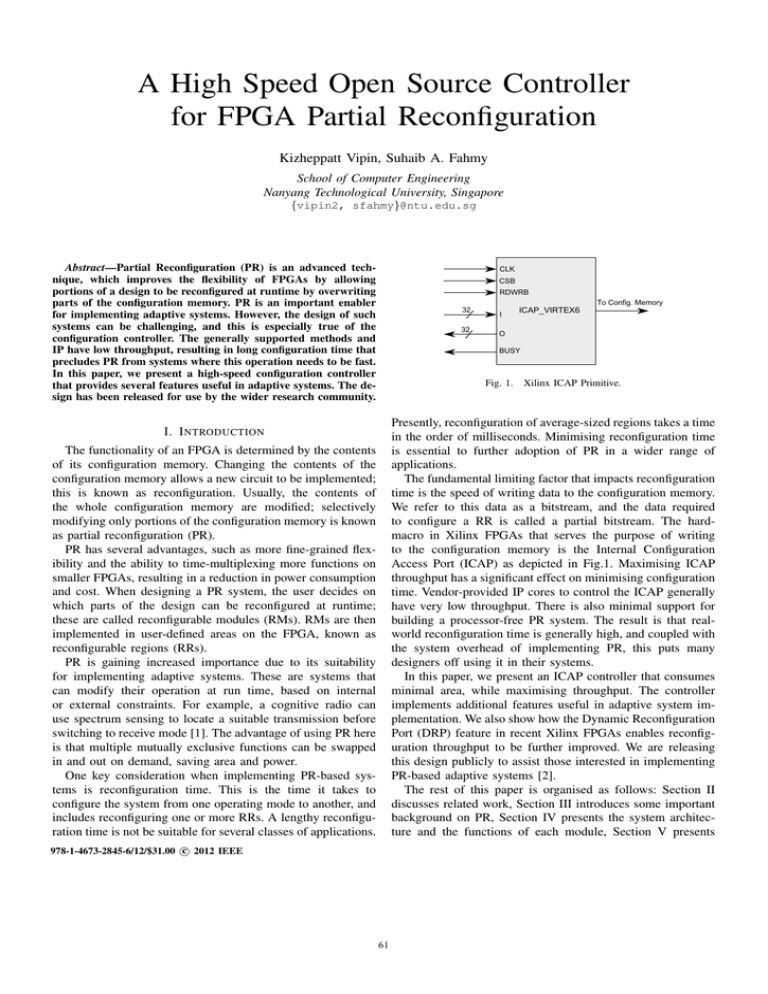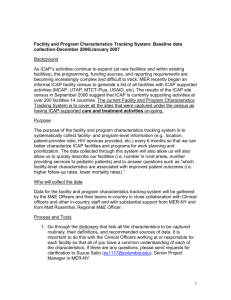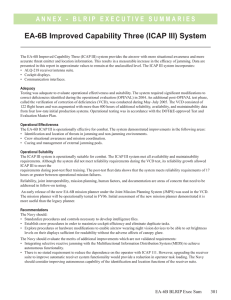A High Speed Open Source Controller for FPGA Partial Reconfiguration
advertisement

A High Speed Open Source Controller
for FPGA Partial Reconfiguration
Kizheppatt Vipin, Suhaib A. Fahmy
School of Computer Engineering
Nanyang Technological University, Singapore
{vipin2, sfahmy}@ntu.edu.sg
Abstract—Partial Reconfiguration (PR) is an advanced technique, which improves the flexibility of FPGAs by allowing
portions of a design to be reconfigured at runtime by overwriting
parts of the configuration memory. PR is an important enabler
for implementing adaptive systems. However, the design of such
systems can be challenging, and this is especially true of the
configuration controller. The generally supported methods and
IP have low throughput, resulting in long configuration time that
precludes PR from systems where this operation needs to be fast.
In this paper, we present a high-speed configuration controller
that provides several features useful in adaptive systems. The design has been released for use by the wider research community.
CLK
CSB
RDWRB
32
32
I
ICAP_VIRTEX6
To Config. Memory
O
BUSY
Fig. 1.
Xilinx ICAP Primitive.
Presently, reconfiguration of average-sized regions takes a time
in the order of milliseconds. Minimising reconfiguration time
is essential to further adoption of PR in a wider range of
applications.
The fundamental limiting factor that impacts reconfiguration
time is the speed of writing data to the configuration memory.
We refer to this data as a bitstream, and the data required
to configure a RR is called a partial bitstream. The hardmacro in Xilinx FPGAs that serves the purpose of writing
to the configuration memory is the Internal Configuration
Access Port (ICAP) as depicted in Fig.1. Maximising ICAP
throughput has a significant effect on minimising configuration
time. Vendor-provided IP cores to control the ICAP generally
have very low throughput. There is also minimal support for
building a processor-free PR system. The result is that realworld reconfiguration time is generally high, and coupled with
the system overhead of implementing PR, this puts many
designers off using it in their systems.
In this paper, we present an ICAP controller that consumes
minimal area, while maximising throughput. The controller
implements additional features useful in adaptive system implementation. We also show how the Dynamic Reconfiguration
Port (DRP) feature in recent Xilinx FPGAs enables reconfiguration throughput to be further improved. We are releasing
this design publicly to assist those interested in implementing
PR-based adaptive systems [2].
The rest of this paper is organised as follows: Section II
discusses related work, Section III introduces some important
background on PR, Section IV presents the system architecture and the functions of each module, Section V presents
I. I NTRODUCTION
The functionality of an FPGA is determined by the contents
of its configuration memory. Changing the contents of the
configuration memory allows a new circuit to be implemented;
this is known as reconfiguration. Usually, the contents of
the whole configuration memory are modified; selectively
modifying only portions of the configuration memory is known
as partial reconfiguration (PR).
PR has several advantages, such as more fine-grained flexibility and the ability to time-multiplexing more functions on
smaller FPGAs, resulting in a reduction in power consumption
and cost. When designing a PR system, the user decides on
which parts of the design can be reconfigured at runtime;
these are called reconfigurable modules (RMs). RMs are then
implemented in user-defined areas on the FPGA, known as
reconfigurable regions (RRs).
PR is gaining increased importance due to its suitability
for implementing adaptive systems. These are systems that
can modify their operation at run time, based on internal
or external constraints. For example, a cognitive radio can
use spectrum sensing to locate a suitable transmission before
switching to receive mode [1]. The advantage of using PR here
is that multiple mutually exclusive functions can be swapped
in and out on demand, saving area and power.
One key consideration when implementing PR-based systems is reconfiguration time. This is the time it takes to
configure the system from one operating mode to another, and
includes reconfiguring one or more RRs. A lengthy reconfiguration time is not be suitable for several classes of applications.
c 2012 IEEE
978-1-4673-2845-6/12/$31.00 61
Statistics
the implementation results and a comparison with previous
implementations, and Section VI concludes the paper.
II. P REVIOUS W ORK
Reconfiguration time in PR systems depends upon a number
of factors. System-level design decisions, such as the number
of regions to use and how modules are allocated to regions,
can make a modest impact. Efficient partitioning [3] has been
shown to have some impact, while bitstream compression
[4] has also been suggested. Considered floorplanning of
PR regions has also been shown to have an impact [5].
However, the fundamental limit is governed the speed at which
bitstreams can be written to the configuration memory.
Traditionally, the reconfiguration operation is controlled by
a processor, through a vendor-provided ICAP controller such
as the OPBHWICAP or XPSHWICAP, connected as a slave
device to the processor bus [6], [7]. Using these vendorprovided controllers gives low throughput in the region of
4.66-10.1 MBytes/sec [8], [9]. This should not be the case,
as the ICAP hard macro itself supports speeds of up to 400
MBytes/sec.
In [10], the authors proposed to connect the ICAP controller
to the fast simplex link (FSL) bus of the processor. The
drawback is that the processor becomes consumed with the
task of requesting configuration data from the external memory
and sending it over the FSL bus. The resulting throughput of
under 30 MBytes/sec remains well below the theoretical limit
of the ICAP.
Using DMA to transferring partial bitstreams from external
memory has previously been shown to be effective in increasing throughput [11]. Elsewhere, some have tried to achieve
better performance by over-clocking the ICAP primitive [12].
Since the maximum frequency at which the controller can
operate depends upon manufacturing variability and specific
placement and routing, this would need to be determined on
a device-by-device basis, which is cumbersome.
Other work on optimised ICAP controllers has often made
unrealistic assumptions, such as the complete configuration
bitstream being stored in FPGA Block RAM [9]. This is
not practical, as FPGAs have limited memory that is often
insufficient for even a small number of bitstreams, and these
memories are often required for system implementation.
In [13], the authors review a significant number of ICAP
controllers and evaluate their performance. They also develop
a cost model for determining the performance of controllers.
They consider a real system architecture, where bitstreams
are initially fetched from external memory into FPGA local
memory, and later used for configuration.
In this paper, we present an ICAP controller for PR systems
that enables the loading of bitstreams from external memory
at speeds very close to the theoretical limit of the ICAP
primitive, while consuming minimal area. We further enhance
the controller’s capabilities with features that assist in the
implementation of adaptive systems that use PR. We compare
our work with previous implementations, and show that it is
both faster, and more compact.
UART I/F
FIFO 256
I/F
8
DMA
Ctrl. 256
Conf.
Pointer
Buffer
64
256
ICAP
Ctrl.
Fig. 2.
DDR
Ctrl.
32
ICAP
System architecture.
III. PARTIAL R ECONFIGURATION OVERVIEW
Xilinx supports PR through their software package, PlanAhead. First, the whole design is partitioned into static logic and
a number of reconfigurable modules (RMs). The functionality
of the static logic does not change during runtime. Reconfiguration control must be implemented in the static logic.
The netlist for each RM is generated using Xilinx XST or
any third-party synthesis tools. During design time, each RM
is assigned to a reconfigurable region (RR). RRs should be
rectangular in shape and are composed of different FPGA
primitives such as configurable logic blocks (CLBs), Block
RAMs etc. The smallest addressable segment of the FPGA
configuration memory is known as a frame. Partial bitstreams
corresponding to every required configuration for each RR are
generated using PlanAhead and the associated tool-chain. The
size of the bitstream is proportional to the size of the RR in
frames, and this directly determines reconfiguration time for
the region.
The ICAP is a hard macro present in the FPGA, which
is used to access the configuration memory from within.
The ICAP present in Virtex-6 devices, ICAP VIRTEX 6, is
shown in Fig. 1. The ICAP data interface can be set to one
of three data widths: 8, 16, or 32 bits. CSB is the activelow interface select signal, RDWRB is the read/write select
signal. BUSY is valid only for read operations and remains low
for write operations. The maximum recommended frequency
of operation for the ICAP is 100 MHz.
IV. S YSTEM A RCHITECTURE
The overall system architecture for our controller is shown
in Fig. 2. The design we present here functions within an
adaptive system, for which we define two phases. The first
is the preparation phase, in which all the required partial
bitstreams are fetched from outside the system, and stored in
the on-board memory of the adaptive system. These bitstreams
may originate from a file system on some non-volatile storage,
or alternatively be sent from a host PC. In the latter case, we
can use a simple interface such as UART, as this preparation
phase is not time-critical. The bitstreams are read in over
62
this interface, then pushed through DMA into the external
memory, while storing their location labels in a Configuration
Pointer Buffer for later use. Once preparation is complete, the
system enters the runtime phase, where the adaptive system
can now autonomously load partial bitstreams and reconfigure
regions. This involves the transfer of partial bitstreams from
the on-board memory to the ICAP controller using the DMA
controller.
parameters are stored automatically when the DMA controller
transfers partial bitstreams to the external memory in the
preparation phase. Each set of parameters has a reference
number, which is their ordinal number of transfer from the host
system. The advantage of using this buffer is that when the system is in the runtime phase, an adaptation controller can load
partial bitstreams using just their pointer label, rather than it
having to be aware of any further bitstream details. The DMA
engine configurations as well as programming sequences are
done automatically by the state machine controlling this buffer.
A. DDR Memory Controller
The DDR controller controls the external memory based
on the commands from the DMA controller. This is a DDR3
controller, which controls a 64-bit wide external memory. This
core is generated using Xilinx’s memory interface generator
(MIG) wizard [14]. The core’s read and write data ports are
256 bits wide and run at 200 MHz.
E. Statistics
The statistics block contains two hardware counters for
system performance monitoring. The first counter measures the
overall performance by measuring the number of clock cycles
required for reconfiguration to complete after the command is
issued. The second counter measures the performance of the
ICAP controller.
The values present in these registers can be accessed from
a host system through the UART interface, or used within the
rest of the adaptive system. The presence of hardware counters
provides precise system performance measures in comparison
to inaccurate software counters. that can be utilised by the
adaptive control for efficient system management.
Another parameter monitored by this block is the number of
times each partial bitstream is used for reconfiguration. In an
adaptive system scenario, this information gives an overview
of the conditions in which the system is operating, since
different partial bitstreams are used depending upon system
conditions. This information can be later used for further
PR design optimisation such as region partitioning [3] and
improved performance through configuration prefetching [15].
B. DMA Controller
The DMA controller is an important component in this system, and is largely responsible for the high speed. This block
performs a DMA write operation to store partial bitstreams
in the external memory during the preparation phase, as well
as reading the bitstreams from memory when reconfiguring
regions in the runtime phase. Before storing a partial bitstream
to memory, the DMA controller is armed with the DMA
transfer length in bytes and the starting memory location at
which to store the bitstream. This information is provided to
the controller using two internal registers, which can be set
by the external host. During the write operation, the DMA
controller keeps track of the number of bytes present in the
FIFO, and whenever sufficient data is present for a write
operation (here, 64 bytes), it is transferred to the memory controller. During read operations, the DMA controller instructs
the memory controller to generate memory read sequences,
until the specified number of bytes are read. To achieve high
throughput, the controller issues back-to-back read commands.
For read operations, the address and data length can be
obtained either from a host system, or from the configuration
pointer buffer. The DMA controller and the memory controller
coordinate their operations using a producer-consumer model
handshake.
F. UART
The system can interface with an external host using a serial
interface. This RS-232 interface can be used to transfer partial
bitstreams into external memory and for issuing commands
from a host PC. A simple serial interface has several advantages including the lack of a special driver being needed for
communication. In a completely self-contained system, there
is no need for this interface, as the bitstreams can be fetched
internally from non-volatile memory during the preparation
phase. The commands available for host system control are
listed in Table I.
C. FIFO Interface
Partial bitstreams are temporarily stored in a FIFO before
being loaded into the DDR memory from the host system.
This interface serves two purposes: the host interface can be
changed without affecting the remainder of the system, and
data can be packed, allowing the host interface width to be
different from the data width of the system memory interface.
At present, UART data comes in one byte at a time and
the system memory controller write width is 32 bytes; this
difference is managed by the FIFO interface.
G. ICAP Controller
The detailed architecture of the ICAP controller is shown
in Fig. 3. It consists of an asynchronous FIFO, clock manager
(MMCM), ICAP control state machine (ICAP SM) and the
ICAP hard-macro. The asynchronous FIFO is used to temporarily store the partial bitstreams from external memory, before sending to the ICAP macro. The system is able to achieve
high throughput due to the presence of the asynchronous FIFO
that has different read and write clock frequencies. The depth
of this FIFO can be configured to achieve better performance.
Operation of read and write ports is managed using the fifo full
D. Configuration Pointer Buffer
This buffer stores the size of the partial bitstreams as
well as their starting location in the external memory. These
63
TABLE I
S UPPORTED H OST C OMMANDS .
Command
SRST
SLEN
SADR
CMOD
DMOD
PICP
CINT
RST1
RST2
NCON
SCFQ
Action
Soft Reset: Reset all logic except the memory controller
Set byte transfer length for DMA
Set the starting address for DMA
Command mode: Disable DMA controller
Data mode: Enable DMA controller
Start reconfiguration
Reconfiguration using the pointers from config. buffer
Read statistics register 1
Read statistics register 2
Number of times the specified partial bitstream is used
Set ICAP clock frequency
Fig. 3.
and fifo empty signals, synchronised with the write and read
clock domains, respectively. In our design, the write clock
frequency is equal to the DDR controller clock frequency and
the write data width is 256 bits. Whenever valid data emerges
from the DDR memory, it is stored in this FIFO. The read
clock frequency of the FIFO is equal to the ICAP controller
clock frequency, and the read width is set to the maximum
allowable 32 bits for performance.
An MMCM (mixed-mode clock manager) is used to derive
the required ICAP clock frequency from the on-board clock
source. The MMCM output clock frequency is set to 100 MHz,
which is the maximum frequency recommended by Xilinx.
During PR, we are only interested in writing into the
configuration memory, so the read/write port of ICAP is
permanently grounded. As we only support writing to the
ICAP, the controller is more compact than many existing
designs. The write operation to the ICAP is managed by a
state machine that continuously senses the fifo empty signal
of the asynchronous FIFO. Whenever the fifo empty signal is
de-asserted, it indicates valid data is available in the FIFO.
The state machine asserts the read enable signal of the FIFO
and after one clock cycle, asserts the icap enable signal of the
ICAP. When the empty signal becomes high, the read enable
and icap enable signals are de-asserted. In order to minimise
resource utilisation, no counters are implemented in the ICAP
controller to track the number of bytes written to the configuration memory. The DMA controller must ensure that all
required configuration bytes are read from external memory.
The fifo full signal is used by the DMA controller. This
signal is asserted when half the FIFO is filled. Whenever the
DMA controller senses this signal is high, it stops issuing
memory read commands. This signal ensures that no buffer
overflow occurs.
ICAP controller architecture.
TABLE II
R ESOURCE UTILISATION .
Module
ICAP Controller
DMA Controller
Registers
74
598
LUTs
38
548
BRAMs
8
0
Max. Freq.
516
265
which is suitable for one device may not be suitable for another
device, even with the same speed grade, and Xilinx does
not guarantee proper ICAP operation above 100 MHz. Clock
generating circuits cannot be modified using PR, since Xilinx
requires that all the clock modifying components such as
phase locked loops (PLLs) and digital clock managers (DCMs)
reside in the static region. In order to overcome this issue, we
make use of a feature available in the Virtex-6 MMCM known
as the dynamic reconfiguration port (DRP).
The DRP makes it possible to configure the output frequency of the MMCM at runtime. This is achieved by modifying the internal registers of the MMCM using the DRP.
The system starts operation at 100 MHz. Subsequently, the
operating frequency is increased, until the reconfiguration
process fails. The operating frequency is set to be below the
failing frequency.
Presently the clock frequency needs to be manually tuned
by issuing commands from the host system. In future designs,
we will propose ways to automate this process.
V. R ESULTS
The ICAP controller design was synthesised using Xilinx
ISE 13.3, and was implemented using Xilinx PlanAhead 13.3.
In addition to the system discussed in Section IV, two partially
reconfigurable modules were also implemented in order to test
the performance and validate functionality as shown in Fig. 4.
The modules are assigned to two separate regions, one large
and the other small. The system was hardware validated by
testing it on a Xilinx ML605 evaluation board, which contains
a Virtex 6 XC6VLX240T FPGA. The resource utilisation for
the two major modules in the design is given in Table II. The
ICAP controller is able to achieve a maximum frequency of
516 MHz when implemented as a standalone module and the
complete system is able to run at 200 MHz.
H. Using the Dynamic Reconfiguration Port (DRP)
Researchers have tried over-clocking the ICAP to achieve
higher performance. According to Xilinx, the maximum clock
frequency at which ICAP should operate is 100 MHz. It has
been reported that the ICAP can run at up to 550 MHz [12].
The drawback is that this maximum clock frequency depends
upon the device speed grade, manufacturing variability, and
detailed custom placement and routing. A clock frequency
64
Host PC
ML605
DDR3
Ctrlr.
Reconfig
Module
Timer
PLB/AXI Bus
Microblaze
Processor
ICAP
Ctrlr.
Flash
Ctrlr.
UART
Ctrlr.
Config.
Ctrler.
ICAP
PR Design
Fig. 4.
Reg. 1
Reg. 2
Controller Performance Test Setup.
Fig. 5.
P ERFORMANCE COMPARISON
Table III shows the performance of the ICAP controller
as well as overall system performance. These values are
calculated with the help of the statistics counters present in the
system. The theoretical maximum performance is 400 MB/s,
based on the 100 MHz clock and 32-bit ICAP width. Total
performance is slightly less than this due to the initial memory
access latency and because DDR read operations are 64-byte
aligned. As the bitstream size increases, the initial latency
becomes negligible compared to the total reconfiguration time,
and hence the throughput increases. From Table III it can
be seen that the controller takes about 633 microseconds to
configure a 400 CLB region (253096 bytes), an improvement
of 44 times over the Xilinx XPS HWICAP, which would
require 27.8 milliseconds. Our controller would take a few
milliseconds for a near complete FPGA reconfiguration rather
than hundreds of milliseconds.
The maximum throughput and resource utilisation of some
other ICAP controller implementations are shown in Table IV.
Our implementation performs better than all these implementations, and is also highly compact.
In addition, we tried to improve the ICAP performance
by overclocking it using the DRP feature of the MMCM.
The ICAP controller was able to successfully reconfigure
the system up to 210 MHz. Presently we need to manually
verify that there are no configuration errors by checking the
functionality of the reconfigured modules. More thorough
checking would require ICAP read capability, which we will
investigate in future work. The overall system performance for
different clock frequencies is given in Fig. 6. Above 210 MHz,
Implementation
[Liu et al. 2009] [9]
[Claus et al. 2008] [16]
[Manet et al. 2008] [17]
[Liu et al. 2009] [9]
[Liu et al. 2009] [11]
Xilinx (PLB) [7]
Xilinx (AXI) [18]
Proposed (with DMA)
Bitstream Size
(Bytes)
5000
12568
63456
126912
253096
SIZE AND SYSTEM PERFORMANCE .
Recon. Time
(us)
12.86
31.75
159.00
317.50
633.00
ICAP Throughput
(MB/S)
395.50
399.94
399.79
400.00
399.96
TABLE IV
ICAP CONTROLLER IMPLEMENTATIONS
OF
Throughput
(MB/S)
235.20
295.40
353.20
371.40
392.74
8.48
9.10
399.80
Registers
LUTS
BRAMs
1083
NA
NA
963
367
746
477
672
918
NA
NA
469
336
799
502
586
2
NA
NA
32
0
1
1
8
no reconfiguration occurs, and above 300 MHz, initiating a
reconfiguration freezes the whole FPGA. At 210 MHz, the
overall throughput is 838.55 MB/S, which is more than double
the throughput at 100 MHz, resulting in a corresponding
decrease in reconfiguration time.
In order to compare the performance of the widely used
Xilinx ICAP controllers, a typical processor-based PR system
was also implemented as shown in Fig. 5. This system consists
of a MicroBlaze soft processor, a DDR3 memory controller,
the ICAP controller, a timer, Xilinx flash controller, UART
controller, and a reconfigurable module. All the peripheral
devices were initially connected to a 64-bit wide PLBv46 bus.
The partial bitstreams can be stored either in DDR3 memory
or in the flash memory. Partial bitstreams are transferred to
the DDR3 memory using the UART interface and written to
the flash memory using a host flash memory writer. The timer
peripheral is used to determine the time required for reconfiguration. The system runs at 100 MHz with the instruction
as well as data memory implemented in internal BRAMs.
Software for performing the PR operation was written in the C
language using the Xilinx Software Development Kit (SDK),
and the hardware platform was implemented using Xilinx
Embedded Design Kit (EDK) 13.3 and PlanAhead 13.3. The
low-level routines for controlling the ICAP controller as well
as flash memory are taken from Xilinx standard libraries.
Reconfiguration commands are issued from the host system
using the UART interface. If the partial bitstreams are stored in
DDR3 memory, they are transferred using the UART interface
TABLE III
B ITSTREAM
Processor based PR System.
Total Throughput
(MB/S)
388.60
395.84
399.23
399.70
399.80
65
850
minimal resources. Tuning throughput would require the ability to read from the ICAP to verify valid reconfiguration.
We also plan to extend the application of this platform for
processor based designs.
Finally, we are releasing this design in the public domain, so
it can be used by researchers intending to incorporate PR into
their systems, in the hope that it might spur further adoption
of this key capability of FPGAs.
R EFERENCES
800
Total Throughput (MB/s)
750
700
650
600
550
500
Custom design minimum throughput
450
[1] J. Lotze, S. Fahmy, J. Noguera, B. Ozgul, L. Doyle, and R. Esser, “Development framework for implementing FPGA-based cognitive network
nodes,” in Proceedings of IEEE Global Telecommunications Conference
(GLOBECOM), 2009.
[2] ICAP
controller
source
code.
[Online].
Available:
http://www.github.com/archntu/prcontrol.git
[3] K. Vipin and S. A. Fahmy, “Efficient region allocation for adaptive
partial reconfiguration,” in Proceedings of the International Conference
on Field Programmable Technology (FPT), 2011.
[4] Z. Li and S. Hauck, “Configuration compression for virtex FPGAs,”
in Proceedings of IEEE Symposium on Field-Programmable Custom
Computing Machines (FCCM), 2001.
[5] K. Vipin and S. A. Fahmy, “Architecture-aware reconfiguration-centric
floorplanning for partial reconfiguration,” in Reconfigurable Computing:
Architectures, Tools and Applications – Proceedings of the International
Symposium on Applied Reconfigurable Computing (ARC), 2012, pp. 13–
25.
[6] DS280: OPB HWICAP, Xilinx Inc., July 2006.
[7] DS586: XPS HWICAP, Xilinx Inc., July 2010.
[8] C. Claus, F. H. Muller, J. Zeppenfeld, and W. Stechele, “A new framework to accelerate Virtex-II Pro dynamic partial selfreconfiguration.” in
Proceedings of IEEE International Symposium on Parallel & Distributed
Processing, Workshops and Phd Forum (IPDPSW), 2007.
[9] M. Liu, W. Kuehn, Z. Lu, and A. Jantsch, “Run-time partial reconfiguration speed investigation and architectural design space exploration,” in
Proceedings of International Conference on Field Programmable Logic
and Applications (FPL), 2009.
[10] M. Hubner, D. Gohringer, J. Noguera, and J. Becker, “Fast dynamic and
partial reconfiguration data path with low hardware overhead on Xilinx
FPGAs,” in Proceedings of IEEE International Symposium on Parallel
and Distributed Processing Workshops and Phd Forum (IPDPSW), 2010.
[11] S. Liu, R. N. Pittman, and A. Forin, “Minimizing partial reconfiguration
overhead with fully streaming DMA engines and intelligent ICAP
controller,” Microsoft Research, Tech. Rep. MSR-TR-2009- 150, Sept.
2009.
[12] S. G. Hansen, D. Koch, and J. Torresen, “High speed partial run-time
reconfiguration using enhanced ICAP hard macro,” in Proceedings of
IEEE International Symposium on Parallel and Distributed Processing
Workshops and Phd Forum (IPDPSW), 2011.
[13] K. Papadimitriou, A. Dollas, and S. Hauck, “Performance of partial
reconfiguration in FPGA systems: A survey and cost model,” ACM
Transactions on Reconfigurable Technology and Systems (TRETS),
vol. 4, no. 4, pp. 36:1–36:24, Dec. 2011.
[14] UG86: Xilinx Memory Interface Generator (MIG) User Guide, Xilinx
Inc., Sept. 2010.
[15] S. Hauck., “Configuration prefetch for single context reconfigurable
coprocessors,” in Proceedings of ACM/SIGDA International Symposium
on Field-Programmable Gate Arrays (FPGA), 1998.
[16] C. Claus, B. Zhang, W. Stechele, L. Braun, M. Hubner, and J. Becker,
“A multi-platform controller allowing for maximum dynamic partial
reconfiguration throughput,” in Proceedings of the IEEE International
Conference on Field Programmable Logic and Applications (FPL),
2008.
[17] P. Manet, D. Maufroid, L. Tosi, G. Gailliard, O. Mulertt, M. D.
Ciano, J. D. Legat, D. Aulagnier, C. Gamrat, R. Liberati, V. L. Barba,
P. Cuvelier, B. Rousseau, and P. Gelineau, “An evaluation of dynamic
partial reconfiguration for signal and image processing in professional
electronics applications,” EURASIP Journal on Embedded Systems, vol.
2008, pp. 1–11, 2008.
[18] DS817: AXI HWICAP, Xilinx Inc., June 2011.
Custom design maximum throughput
400
Xilinx AXI ICAP controller throughput
Xilinx XPS ICAP controller throughput
350
5
0
100
120
140
160
180
200
220
ICAP Clock Frequency (MHz)
Fig. 6.
Frequency vs Total Throughput.
by calling a routine. When the processor receives a reconfiguration command, it resets the performance measurement
timer and invokes appropriate routines to transfer the partial
bitstream to the ICAP controller depending upon its storage
location. Once the reconfiguration operation is completed, the
timer is halted and the value stored in it is read. The timer
reports the total number of clock cycles required for the
operation, and from this the throughput can be determined.
For the PLB system, Xilinx’s XPS HWICAP [7] was used as
the ICAP controller. When the bitstreams are stored in flash
memory, the reconfiguration throughput is only 0.47 MB/s
and when stored in the DDR3 memory, the throughput is
8.4 MB/s. These values prove that present processor-based
ICAP controllers are unsuitable for time-critical reconfiguration scenarios.
The same experiment was repeated using the latest AXI-bus
based design. In this system, the DDR3 controller is connected
to an AXI4 bus and other peripherals to AXI4-lite bus. The
ICAP controller used in this experiment is the AXI HWICAP
[18]. When using the AXI-bus, system performance is slightly
improved. The reconfiguration throughput while using the
flash is 0.49 MB/s, and using the DDR3 memory to store the
bitstreams gives 9.1 MB/s. These values are still well below
what is possible, as we have shown with our design.
VI. C ONCLUSION AND F UTURE W ORK
In this paper we presented the design of a high speed
reconfiguration controller, which minimises reconfiguration
time and provides additional features for adaptive systems
implementation. The design achieves near to the theoretical
maximum performance of the Xilinx ICAP primitive. The
result is that reconfiguration time is reduced by an order
of magnitude compared to the standard vendor-advised approaches. Furthermore, by using the DRP feature of the
clock generator, the design is able to achieve even higher
performance, with the throughput being adjustable.
In the future, we will investigate how maximum throughput
can be determined automatically. For the design presented in
this paper, we use a write-optimised data path that consumes
66




